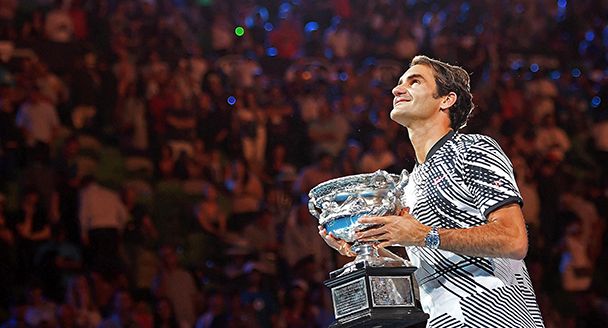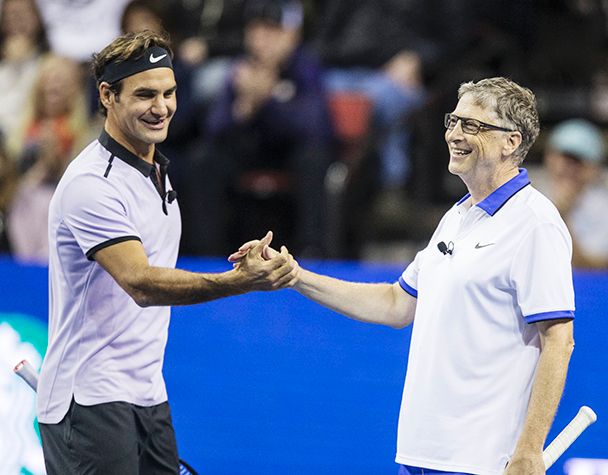This article was originally published on May 30, 2017.
Ah, s—, it’s all happening again.”
Roger Federer remembers the moment, the word, with painful clarity. “Again.”
He was down 3-1 in the fifth set of the 2017 Australian Open final, losing to Rafael Nadal, his career kryptonite. Nadal, who was 6-0 against Federer in grand slams since 2008, pounded forehands at him. Federer felt his legs go heavy. Then heavier. He started talking to himself. “I recall saying, ‘You have to try to break now, pal, because later on he is going to stay in the lead and have the break, and then too much luck is involved to turn the whole thing around.'”
More than any player in the modern era, Roger Federer has made the game look easy. Federer, the graceful. Federer, the perfect. Federer, the ideal tennis player. It’s what makes him so intoxicating to watch. It’s what inspires a near literal traveling church of Roger Federer faithful at ATP events. But what looks easy comes with a soundtrack, an internal monologue, and in that monologue, the greatest male tennis player of all time will sometimes grind hard, full of doubt and pressure and frustration, wrestling with history and ambition, fearful of coming up short.
“Oh, s—, he’s got me at the finish line,” Federer said to himself.
He struggled to calm down. He kept talking, tried to stay positive: “I told myself, ‘I’ve done very little wrong. I’ve played committed. I’ve played bigger with my backhand than I ever have against Rafa. I’ve hit a lot of backhand winners.'”
He was resetting, centering himself in the middle of a free fall. And somewhere in the conversation between Federer and Federer he found the calm he was seeking. This was an unlikely final to be in, coming off a left knee injury at age 35, and the boisterous crowd was with him. He fed on its energy. He remembers it now as some combination of Zen and excitement. “A different mindset,” he says. Instead of getting shaky, he got energized. Instead of reproducing an old pattern, he found something new. “I had the best 20 minutes of my life, maybe, on the tennis court,” he says. “I just zoned in and just went …” He lifts his right hand and mimics a jet taking off. It climbs higher and higher, and then it flies away.
Federer is sitting at a long, lacquered table in a private dining room at the Four Seasons Hotel in downtown Seattle. He is tanned and wears a black Nike top and black Nike sweats. He sits up in his chair, unspooling the moment in Melbourne, excited at the memory of it. “What I was telling myself is ‘Play free,'” he says. “‘Don’t feel like you’re in a straitjacket. Feel like you have nothing to lose, maybe for one of the first times.'”
With Federer serving for the match, Nadal made one last charge, earning two break points and threatening to take back momentum. Federer kept talking to himself, urging himself on: “Just keep not thinking too much about the what-ifs … the pressure, the moment. I know it’s huge, we all know it’s huge, but just try to shake it off. Don’t freeze up. Fight, but don’t try too hard and want it too much.”
He looks out the hotel-room window toward Puget Sound. The sky is clear and blue. “Just like Switzerland,” he says. Snow-covered mountains rise in the distance. The view is scarred by an unsightly gray power plant. He looks past it to the water and the white peaks.
“I let go,” he says.

By winning the Australian Open this year, Roger Federer padded his lead over his two active rivals — Rafael Nadal and Novak Djokovic — on the career Grand Slam titles leaderboard. TRACEY NEARMY/EPA
The 20 minutes in Melbourne have changed the tone and shape of the last phase of Roger Federer’s career.
For as long as he keeps playing tennis, he says, he will seek the feeling he found on that night. He is closing in on two decades as a professional, a record career that includes 18 grand slams, but winning the Australian after a nearly five-year major tournament drought — and against a legion of critics who said his best days might be behind him — feels like a beginning somehow. Never mind making tennis look easy; he is learning how to play the game at ease.
“I’m having a great time,” he says, pouring himself a Pellegrino. “A fantastic time, really.” He doesn’t mean just at Melbourne. He dominated at the BNP Paribas Open in Indian Wells, California, in March, then won another big title in Miami in April. He beat Nadal in all three tournaments, twice without losing a set.
The run seems to be helping him ignore expectations — and retirement chatter — as he picks and chooses the tournaments he plays while his younger rivals push through the ATP tour schedule. Thinking about saving energy, going easy on his surgically repaired left knee and extending his playing days as long as he can, Federer recently opted out of the upcoming French Open; clay courts often mean long, grinding matches, and the surface doesn’t favor Federer’s quick game.
“I can just play the tournaments I want to play and enjoy the process,” he says. “If I do show up and play, I love it. When I’m in training, I enjoy being in training. When I’m not in training, if I’m on vacation, I can enjoy that. I’m not in a rush. So I can take a step back and just actually enjoy.”
He is in Seattle because of Bill Gates. A Federer superfan and dedicated rec-level player, Gates watched his favorite player at Indian Wells. They bonded there over tennis and philanthropy. The Bill and Melinda Gates Foundation has spent billions on improving living standards in Africa. Federer’s foundation also focuses on Africa, especially education for children. They decided to organize an exhibition at the KeyArena in Seattle — Federer vs. John Isner, the tall, big-serving American — as part of a fundraiser for Federer’s charity.
A couple of days before the exhibition, Federer, wife Mirka and a few others from his team visited Gates’ 66,000-square-foot compound on the shores of Lake Washington, called Xanadu 2.0. Before courses of halibut and steak, they spoke about physics and Leonardo da Vinci and his audacious, open-minded genius. Growing up, Federer wasn’t focused on being a student, he says. He stopped going to school at age 16 to play tennis full time. Over the years, he’s tried to soak up knowledge where he can. The night at Gates’ estate was a career high point. “It was so inspiring,” he says. “It was surreal.”
Gates invited his guests into his library. He and Federer paid special attention to a notebook in a glass case — the Codex Leicester, filled with Leonardo’s drawings, theories and thoughts. Gates paid $30.8 million for it in 1994.
Federer stared in amazement. “He tells you that Da Vinci wrote upside down and from right to left — Leonardo da Vinci! — and he was not only great at one thing but he was also great at other things, and you realize how broad somebody’s mind can be. Bill Gates is one of those people too. You can feel it. He makes you — not because he wants to in any way, because he’s super humble — but he just makes you feel so small, in the sense that I know so little. Everything he says just seems really important, and you try to absorb it. I tried really to put my antennas up.”
Over the course of a long weekend, Federer and Gates had two dinners and a lunch together. They practiced tennis in front of an exclusive audience of deep-pocket donors, and Federer presented Gates with a new racket similar to his own, a matte-black Wilson RF97. It was inscribed on the throat with Gates’ profile and renamed the BG97.

Bill Gates is a Federer superfan and dedicated rec-level player. STEPHEN BRASHEAR/EPA
Gates was struck by Federer’s curiosity, and, of course, by his grace. “You know, tennis, it’s sort of physics,” he says. “But it’s also artistic, particularly the way Roger appears to move so effortlessly.” Practicing with Federer, noticing his attention to detail, his meticulous approach, Gates was reminded of a software engineer’s painstaking efforts to make computer programs easy to use. “You’re making impossible things actually look fairly easy because you’ve done so much behind the scenes to understand it,” he says.
At the exhibition, Federer and Gates played a lighthearted set of doubles with Isner and Pearl Jam guitarist Mike McCready. Gates was nervous about playing in front of a crowd. His reputation as a computer genius and philanthropist is unassailable, but what if he embarrassed himself as a tennis player? Federer took him aside. One of the world’s greatest tennis players became a coach. One of the world’s richest men became a student. The lessons were imported from Australia. Be aggressive but loose. Breathe deep. Keep a Zen-like focus on the ball.
“Let go,” Federer said.
“He made it clear,” Gates says, “that we were going to have fun.”
Gates didn’t miss a single serve.
Once a carefully crafted image of Swiss perfection, Federer has long showed only glimpses of his life in carefully choreographed doses. But lately that’s been changing. “I have an easier time sharing these feelings that I have with people,” he says.
He laughed through an impromptu recording of a karaoke moment in January with tour buddies Tommy Haas and Grigor Dimitrov. “We’re starting a boyband #NOTNSYNC,” said his Instagram account. The video went viral. He filmed a practice session in Dubai wearing a microphone, describing drills in real time and taking questions from fans. “I miss you guys,” he said. “That is why I am training so hard and trying to get back, so that we can sort of see each other again.”
At Indian Wells, he held a news conference for elementary school kids and talked kittens and oatmeal and parents. Then he plopped to the floor and did pushups with laughing second-graders. In Miami, he posed for a selfie with a large iguana that trundled around the side courts. “Roger is feeling it,” says Haas, a longtime pro.
At the Met Gala in New York in early May, Federer wore a tuxedo that looked very much like a Federer tuxedo: classic and well-trimmed. But when he turned around, there was a cobra on the back. A bejeweled, tongue-flashing cobra on Roger Federer. Wrap your mind around that. He snapped selfies. They flew across the internet. “I thought, ‘Come on, let’s come up with something cool,'” he says. “I’ve never been so, ‘Let me look good. Let’s do something fun here.'”
Famously private and focused, he says he sometimes muses now about how cool it might be to show up at a public park, surprise people and shoot hoops with them or hit tennis balls. But so far he hasn’t been able to bring himself to do it. He’s still Swiss, after all. Showing up unannounced on someone else’s turf would be impolite. “I’m entering someone’s space, and I would disrupt somebody. … Going to the park and doing that and seeing people’s faces would be very cool. But I don’t know — I’m too shy to do it for now.”
